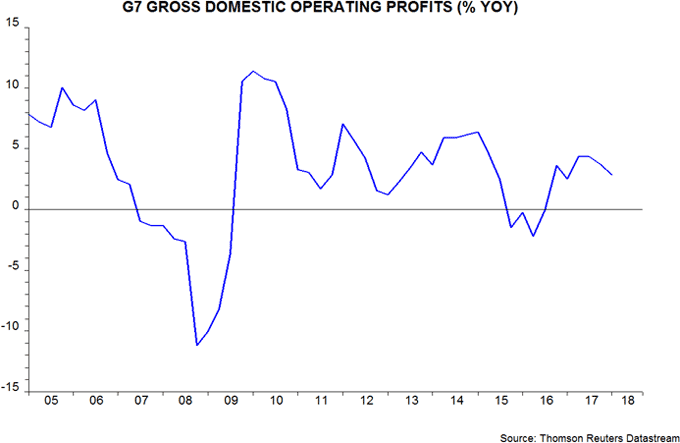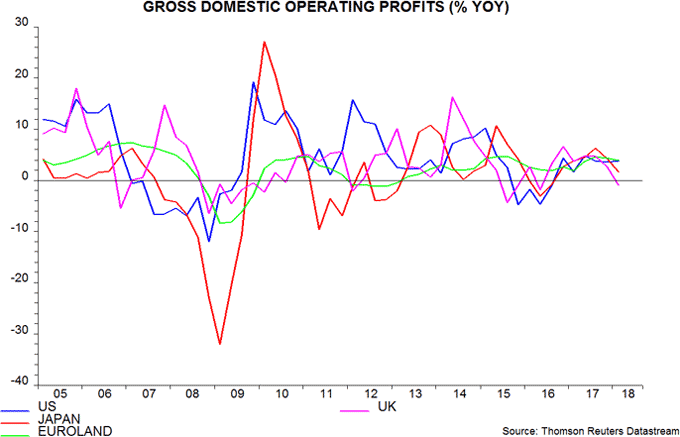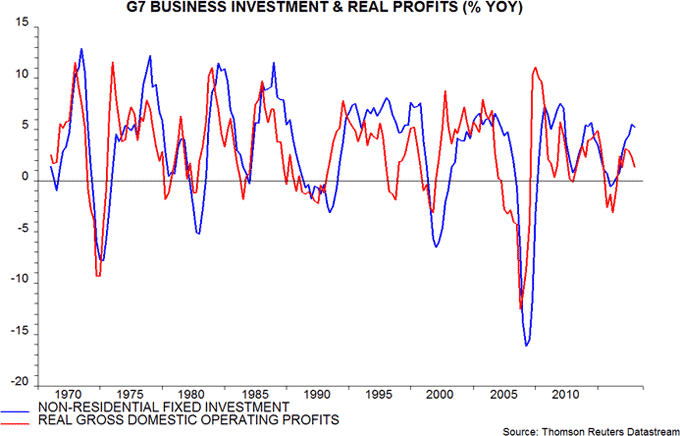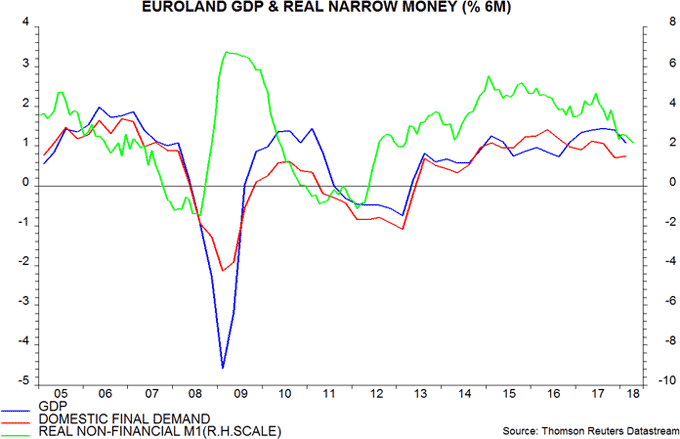Entries from June 1, 2018 - June 30, 2018
Are the profits / investment cycles peaking?
Underlying profits growth in the G7 economies cooled in the first quarter of 2018 and is modest by historical standards, casting doubt on expectations of economic strength based on a further pick-up in business investment.
The underlying profits numbers are from the national accounts and refer to the gross domestic operating surplus of corporations (or the closest available measure), which is equivalent to “EBITDA” (i.e. earnings before interest, tax, depreciation and amortisation). The G7 series is a GDP-weighted average of country data. Annual underlying profits growth was 2.8% in the first quarter of 2018, down from 3.7% in the fourth quarter of 2017 and below an average of 3.8% since 1995 – see first chart.

The G7 series has been dragged down by slowdowns in Japan and the UK. Euroland profits growth has also eased, while US growth has been stable but modest – second chart.

Post-tax US profits, of course, have been boosted by recent tax changes, growing by an annual 8.9% in the first quarter versus 3.9% for the pre-tax measure. Tax cuts, however, are less likely to feed through to business investment if underlying profitability is deteriorating.
Operating margins in the US and several other G7 countries are under threat from rising unit wage cost growth due to stretched labour markets and weak productivity trends. The gap between the US unemployment and job opening rates is an indicator of labour market slack and has displayed a leading relationship with margins historically, with the current message very negative – third chart.

Annual growth of G7 real underlying profits (i.e. current-price profits divided by the GDP deflator) is correlated with, and usually leads, annual business (i.e. non-residential) investment growth. Real profits growth appears to have peaked in the second quarter of 2017, suggesting that investment growth is at or close to a top – fourth chart.

A peak in investment growth would be consistent with the assessment here that the seven- to 11-year Juglar business investment cycle will enter a downswing by 2019. As the fourth chart shows, the annual change in G7 business investment reached lows below -3% in 1975, 1983, 1993, 2002 and 2009. The interval between troughs, that is, ranged from 7.25 to 10.5 years, consistent with the longer-term historical evidence on the length of the Juglar cycle. With the last bottom reached in the second quarter of 2009, another trough is scheduled by the second quarter of 2020 at the latest, implying a downswing starting in 2018-19.
Euroland GDP details downbeat
A post in March argued against consensus positivity about Euroland economic prospects, noting that domestic final demand had already slowed while net export strength was likely to fade as a result of euro appreciation and falling global momentum. GDP expenditure details for the first quarter released today are consistent with this assessment. Monetary trends suggest further weakness in domestic final demand while net exports may continue to struggle without a much more significant fall in the exchange rate.
The GDP report confirmed a 0.4% increase in the first quarter, down from 0.7% in the fourth quarter of 2017. Domestic final demand – i.e. consumption and fixed investment – rose by 0.35%, while net exports subtracted 0.15 percentage points (pp) from the quarterly GDP change. Total final demand, therefore, expanded by just 0.2%, down from 0.8% in the fourth quarter. GDP growth was supported by a 0.2 pp contribution from inventories – stockbuilding rose to a nine-quarter high.
Euroland narrow money trends lead GDP developments but appear to have an even closer relationship with domestic final demand. Two-quarter demand growth peaked as long ago as the second quarter of 2016, following a peak in six-month real narrow money growth in January 2015 – see chart. The two-quarter demand change recovered slightly in the first quarter, as expected here in March on the basis of a temporary revival in narrow money trends in the first half of 2017. The subsequent fall in real narrow money growth to a five-year low in April suggests that domestic final demand will slow further into late 2018 / early 2019.

Net exports are unlikely to take up the slack against the backdrop of an expected global economic slowdown and a current effective exchange rate level still 3% above its 2017 average (Bank of England measure).
The rise in inventories in the first quarter, meanwhile, was probably involuntary and fits with the view here that the global stockbuilding (Kitchin) cycle is approaching a peak and will act as a drag on economic growth in late 2018 / 2019.
Leading indicators still softening
The OECD’s G7 composite leading indicator continues to soften, supporting the forecast here, based on monetary trends, of a global economic slowdown.
The OECD will publish an April update of its leading indicators on 13 June but most of the component information is already available, allowing an independent calculation.
The first chart shows the ratio of G7 GDP to the OECD’s estimate of trend together with the "normalised" (i.e. trend-adjusted) leading indicator – both official and independently-calculated. The indicator is estimated to have declined again in April, increasing the likelihood that the recent peak marked a significant turning point. The indicator, that is, has switched from signalling above-trend economic expansion in 2017 to below-trend now.

The estimated April decline in the indicator was again driven by European countries and Japan but the rise in the US indicator slowed, suggesting that it is approaching a turning point – second chart.

The components of the US indicator are: housing starts, durable goods orders, consumer sentiment, the ISM manufacturing purchasing managers’ index, average weekly hours worked in manufacturing, share prices (NYSE composite) and the slope of the yield curve (10-year Treasury yield minus effective fed funds rate). All components enter as deviations from their estimated trends. The recent slowdown in the indicator reflects negative contributions from the survey measures (consumer sentiment, ISM PMI), share prices and housing starts; its continued rise has been driven by the “hard” manufacturing components – durable goods orders and average weekly hours.
The OECD country indicators do not, in most cases, include a monetary aggregate, so they provide an independent, though less timely, cross-check of monetary signals. Another drawback relative to the monetary data is that the indicators can sometimes be revised significantly, mainly reflecting changes to the estimated trends in the components as new information is incorporated.
Will global money trends recover?
Near-complete April monetary statistics confirm an earlier indication that six-month growth of real narrow money in the G7 economies and seven large emerging economies was little changed from March and above the nine-year low reached in February. The earlier monetary slowdown signals a likely loss of global economic momentum through late 2018 but prospects are no longer deteriorating. Real broad money growth has also recovered slightly since February – see first chart.

Will monetary trends revive more significantly into mid-year, implying a brighter economic outlook for end-2018 and early 2019? Such a scenario is possible but does not currently seem likely.
The recovery in G7 plus E7 six-month real money growth since February has been driven by a slower rate of increase of consumer prices (seasonally adjusted) – nominal money growth was unchanged between February and April. Recent firmer commodity prices suggest that six-month inflation will stabilise or partially retrace the recent decline.
The sideways move in G7 plus E7 real narrow money growth between March and April conceals a decline in G7 expansion offset by a pick-up in the E7 – second chart. Real money growth rose in China, Brazil, India, Russia and Taiwan. Recent capital outflows from emerging markets and an associated tightening of domestic financial conditions, however, could be reflected in weaker monetary trends in some countries.

Previous posts discussed the possibility that US money trends would rebound in lagged response to tax cuts, mirroring experience after previous large reductions. No pick-up is yet evident: six-month narrow money growth fell back in April and is unlikely to have increased in May – the third chart includes a May estimate based on weekly data through 21 May.

US and G7 money growth is probably being dragged down by slowing QE, with the 12-month running total of purchases of government and agency securities by the Fed, Bank of Japan, ECB and Bank of England already down by almost a half from its March 2017 peak and projected to continue to decline rapidly – fourth chart.

The six-month rate of change of real narrow money is lower than a year ago in almost all developed economies (exception: New Zealand) and has been negative for several months in Australia, where the housing market is slowing sharply in response to a belated regulatory clampdown on loose lending standards – fifth and sixth charts.


A recovery in money growth is likely in China, reflecting a recent policy shift towards modest easing and an associated fall in market rates. The timing and extent of any rebound, however, are uncertain: the two-year government yield is only 30 basis points lower than a year ago while previous significant reversals higher in narrow money growth have been preceded by a decline of at least one percentage point – seventh chart.


